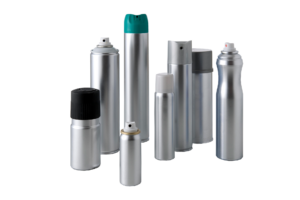Spray cans

Many products of daily life are available as spray: deodorants or hair spray, room sprays, shaving foam, insecticides and pesticides, chain sprays for bicycles, paints, assembly foam (PUR foam), but also food such as spray cream, to give just a few examples. Apart from advantages, spray cans also have disadvantages. Regardless of the ingredients, they pose a danger because they are filled with propellant gas. This is under pressure and can explode at higher temperatures or improper use.
The previously used propellant CFC (Freon®, Frigen®), which is a major cause of the destruction of the ozone layer and a high global warming potential, has been banned for spray cans since 1991. However, it can be found in older products, but today mainly propane and butane are used as propellants. These gases are highly flammable (they are also used in camping gas cookers). They do not endanger the ozone layer, but they contribute to global warming if they are released uncontrollably.
Another danger lies in the components of the spray cans. Even ’empty’ spray cans contain more or less large quantities of residues. If it is a problem substance, such as oil or insecticides, improper handling can lead to environmental hazards.
After crushing, metals are recovered and residues are thermally recycled (see resources potential).
Our tips :
- There are alternatives for most products: such as roll-on deodorant, shaving soap, home-made whipped cream.
- If you do not want to give up the advantages of spraying, use simple pump sprayers where possible.
- Never leave spray cans in the car or other places that heat up or are exposed to direct sunlight when temperatures are high.
Footnotes

Spray cans
Many products of daily life are available as spray: deodorants or hair spray, room sprays, shaving foam, insecticides and pesticides, chain sprays for bicycles, paints, assembly foam (PUR foam), but also food such as spray cream, to give just a few examples. Apart from advantages, spray cans also have disadvantages. Regardless of the ingredients, they pose a danger because they are filled with propellant gas. This is under pressure and can explode at higher temperatures or improper use.
The previously used propellant CFC (Freon®, Frigen®), which is a major cause of the destruction of the ozone layer and a high global warming potential, has been banned for spray cans since 1991. However, it can be found in older products, but today mainly propane and butane are used as propellants. These gases are highly flammable (they are also used in camping gas cookers). They do not endanger the ozone layer, but they contribute to global warming if they are released uncontrollably.
Another danger lies in the components of the spray cans. Even ’empty’ spray cans contain more or less large quantities of residues. If it is a problem substance, such as oil or insecticides, improper handling can lead to environmental hazards.
After crushing, metals are recovered and residues are thermally recycled (see resources potential).
Our tips :
- There are alternatives for most products: such as roll-on deodorant, shaving soap, home-made whipped cream.
- If you do not want to give up the advantages of spraying, use simple pump sprayers where possible.
- Never leave spray cans in the car or other places that heat up or are exposed to direct sunlight when temperatures are high.






